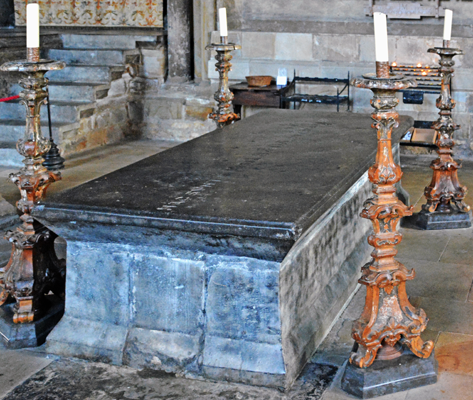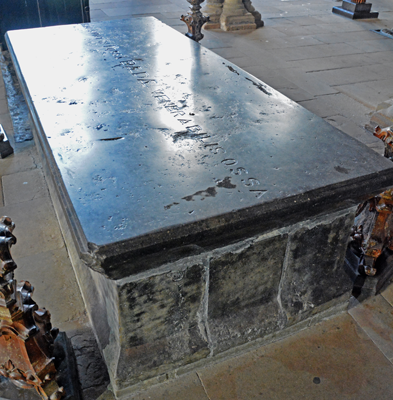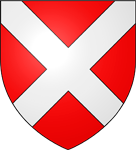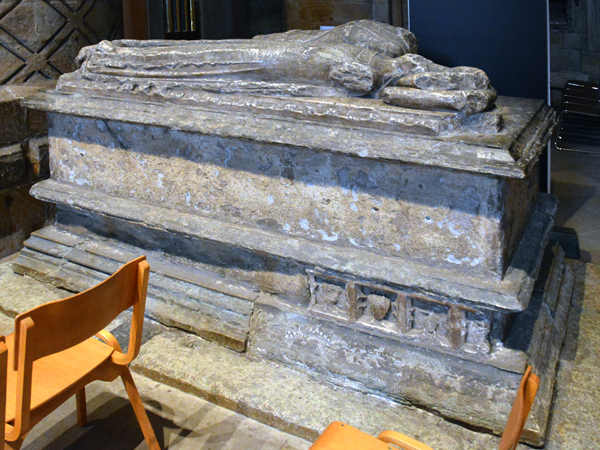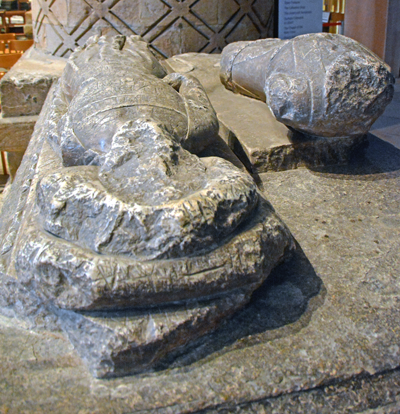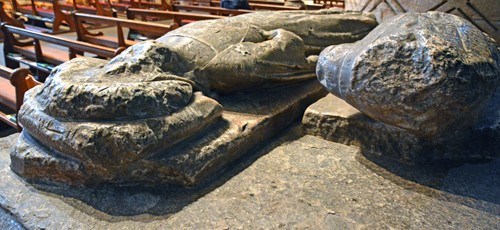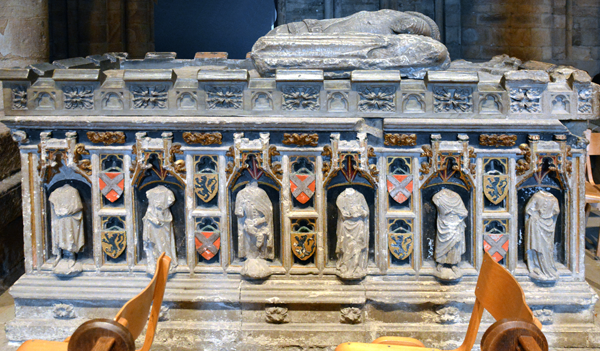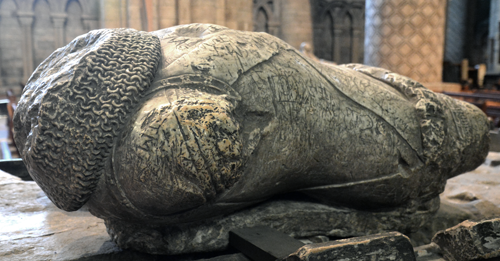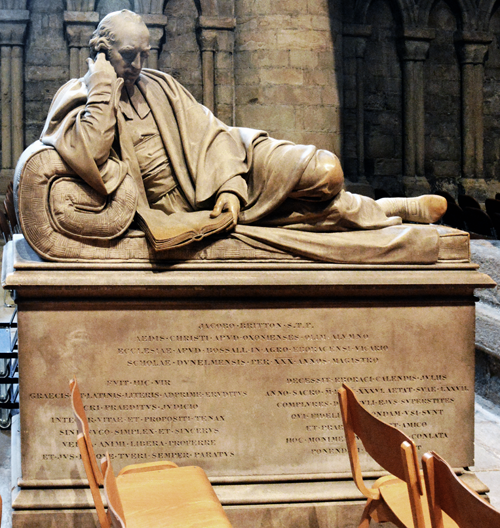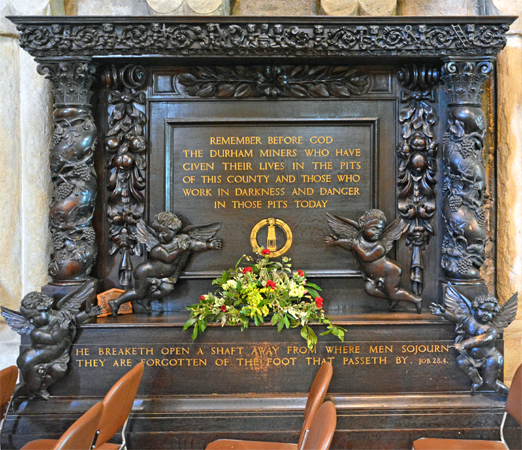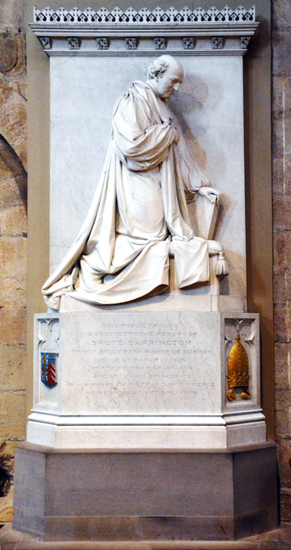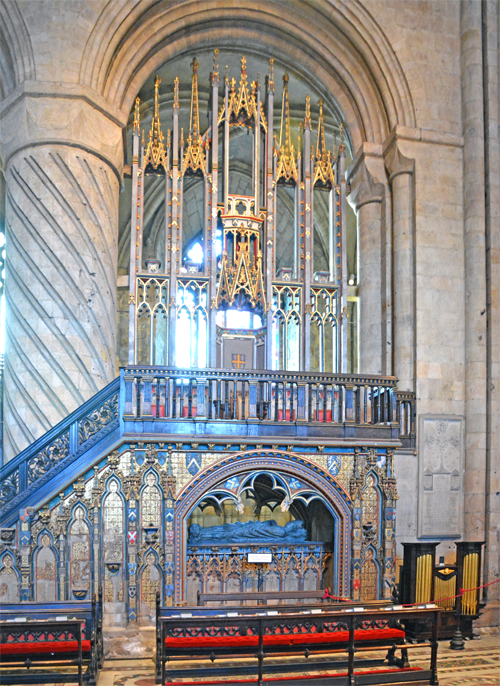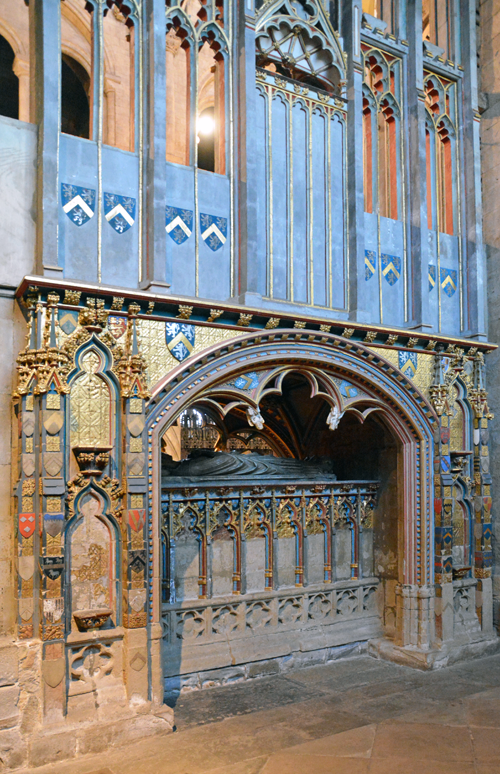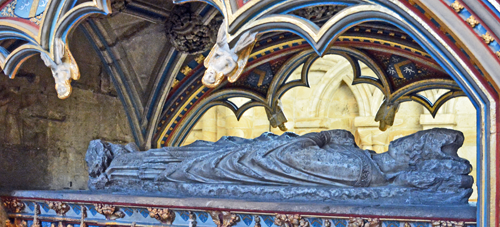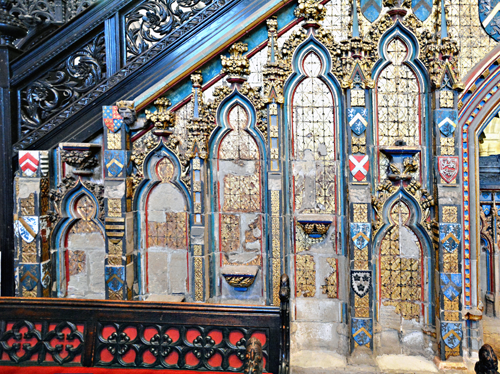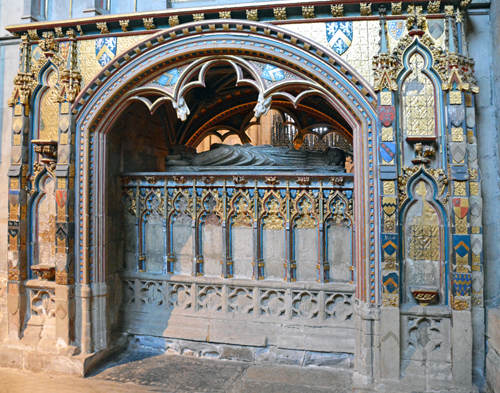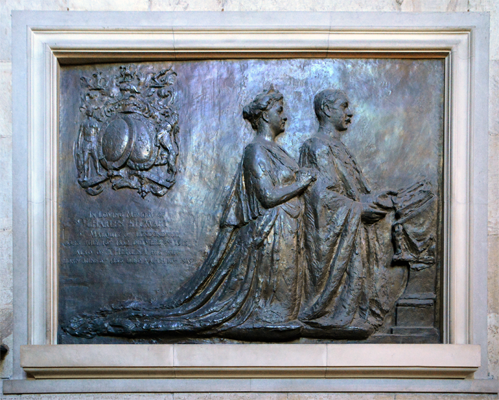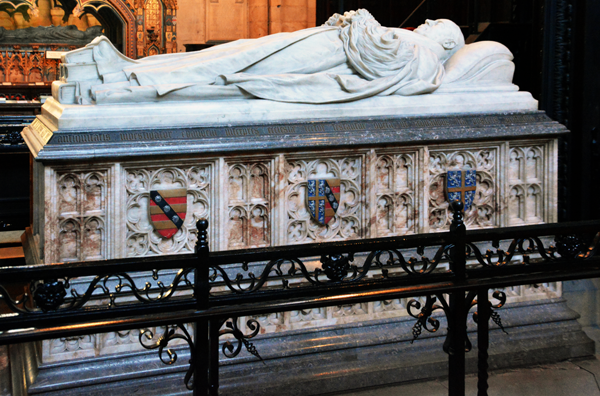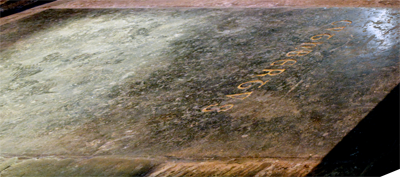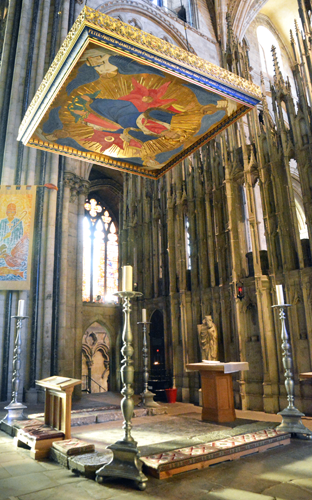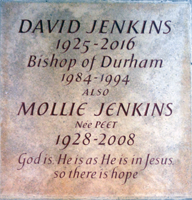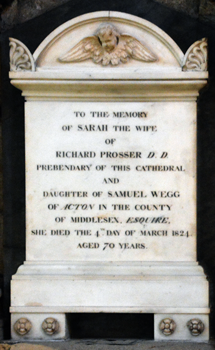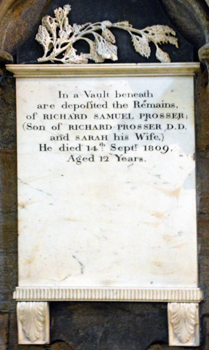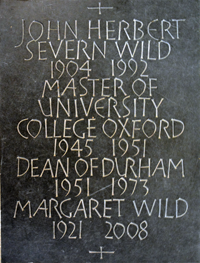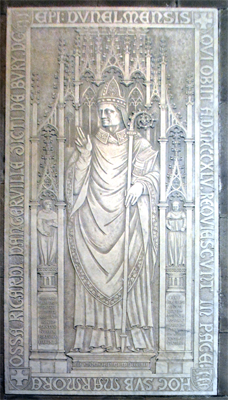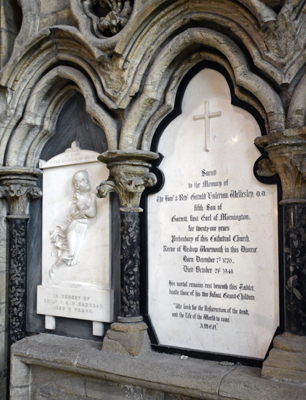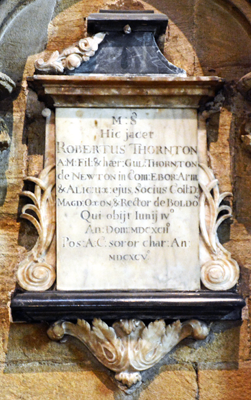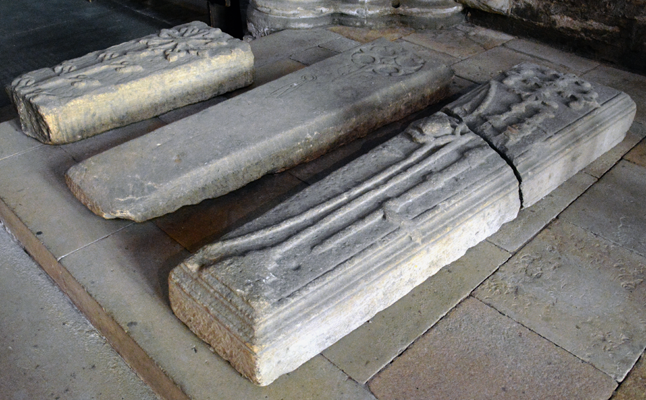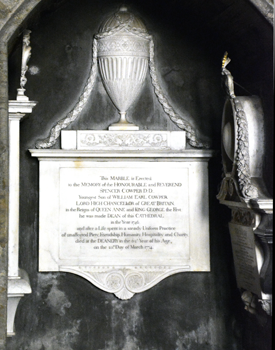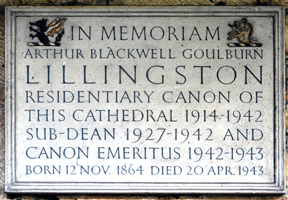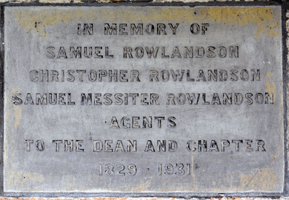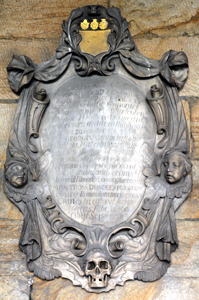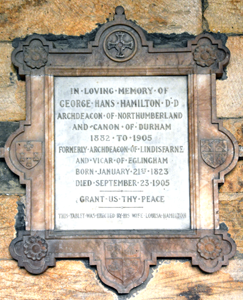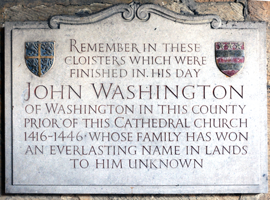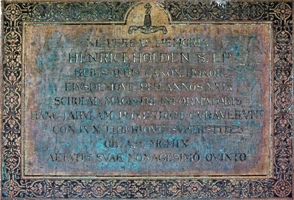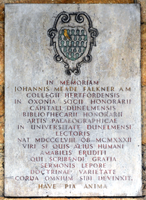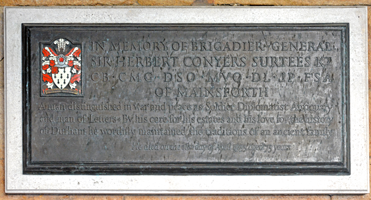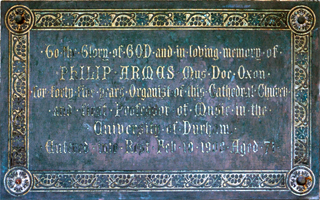| CITY OF DURHAM |
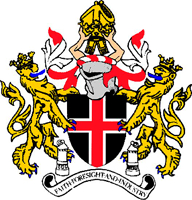 |
|
|
Durham Cathedral St Margaret of Antioch
St Mary the Less
St
Oswald <County of Durham> <County of Durham - 2> |
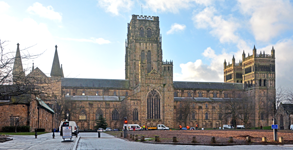 |
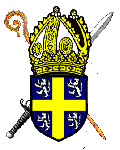 |
Durham Cathedral |
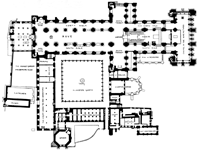 |
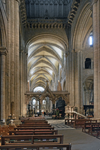 |
| The see of Durham was founded at Lindisfarne
in 635, moved to Chester-le-Street in 883, and finally to Durham
in 997. Durham is a Cathedral of the New Foundation, in the sense that before the Reformation it was a Benedictine Cathedral Priory being staffed by a prior and monks. At the Reformation it was refounded as a secular cathedral being staffed by a dean and canons |
| Durham Cathedral is properly known as The Cathedral Church of Christ and the Blessed Virgin Mary at Durham |
| Please note: I have normally in the past divided a cathedral into sections (transepts, choir etc) and listed the monuments in their correct places but I was unable to correlate them in every case with the entries for the Cathedral in Pevsner's Buildings of England, County Durham, which is selective in listing monuments. I have - for the time being - listed some monuments in a Locations not Found section. There are also other monuments which will be included later. |
| The Galilee Chapel |
| Also known as the Galilee Porch |
Right bottom: In the back ground is the tomb Bishop Thomas Langley (c. 1363 - 1437). He was elected Bishop of Durham in 1406, a position he held until his death; he may be considered as much a politician, for example, holding the post of Lord Chancellor twice, as a high ranking churchman. The link gives a short but interesting biography. His large tomb (a little foreshortened in the photograph) is quite plain but has steps on either side leading to an altar. When built the whole structure blocked the Great West door but doors on either side of the tomb were cut through in the mid 19th century. In the middle ground is the ledger stone of Dorothy Grey (1660), which may be seen more clearly in the photograph above. In the fore ground is a wooden carving of The Annunciation by Polish sculptor, Jósef Pyrz. Also: Dean Allington (1955) no illustration available |
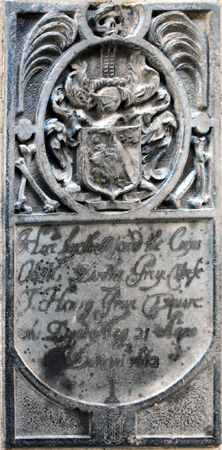 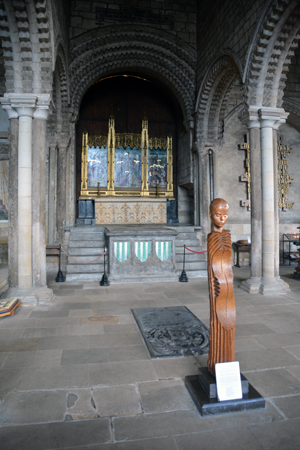 |
|||||||
| Meaning of Venerable |
| The word venerable has three fairly
distinct meanings: 1. Referring to a person who has earned much respect, especially because of age, wisdom, or character. The related verb is to venerate. 2. In the Anglican Church it is a title given to a archdeacon. An archdeacon is a post rather than an order: an archdeacon must be an ordained priest. 3. In the Roman Catholic Church it is a title given to a worthy dead person who has not (yet) achieved beatification or sainthood. In the case of Bede, definition 1 or 3 would seem to apply. |
| Nave & Aisles |
|
|||||||||||||||||||||||
|
|||||||||||||||||||||||||||||||||||||||||||||||||||||||||||||||||
| Locations not yet Recorded | ||||||
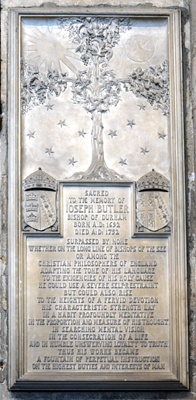 |
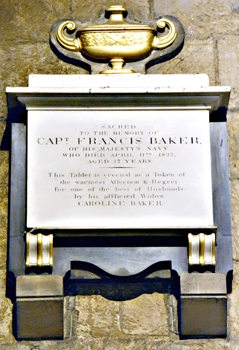 |
 |
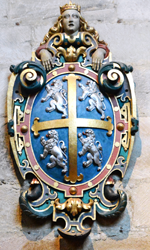 |
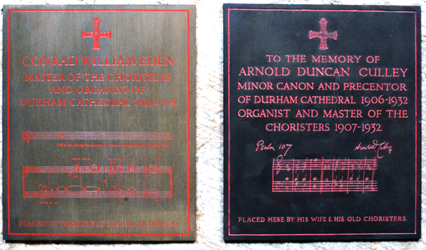 |
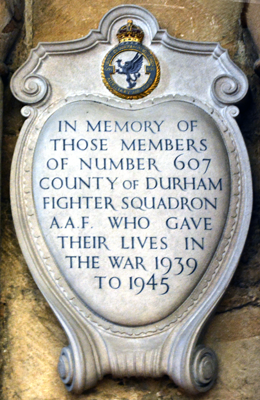 |
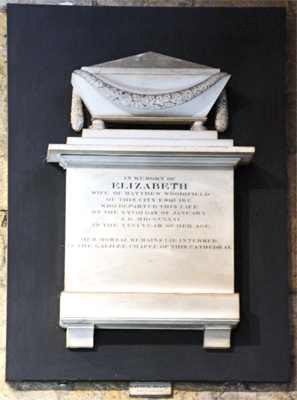 |
| Left:
Joseph Butler (1752) Bishop of
Durham 1692-1752 Above from left to right: 1) Cpt Francis Baker RN (1823) 2) Officers of the 68th (The Durham) Light Infantry. Mjr Heneage Griffith Wynne; Cpt Richard Lloyd Edwards; Lt Frederick Grote Barker; Lt James Marshall; Assistant Surgeon John Francis O'Leary, who were KIA in the Crimea. Lt Col Harry Smyth, who DOW received in action at Scutari; Lt Harry Edmund Smyth, who died of fever in the Crimea. Captain Thomas Whitmore Storer; Paymaster William Hadley; Assistant Surgeon Alexander Johnston, who were invalide from the Crimea and died shortly afterwards. And of, 6 Serjeants, 13 Corporals, 4 Buglers, and 235 Privates of the Regiment, who were KIA, DOW or died of disease in the East during the Russian War 1854,55,56. 3) A wooden board below the above tells us that 'the shield bearing the arms (?) of St Cuthbert were restored and replaced in memory of Dawson Dawson-Walker Canon and Professor of Divinity 1919-1934.' 4) Conrad Williameden Master of the Choristers and Organist 1936-1974. 5) Arnold Duncan Culley Minor Canon and Precentor 1906-1932. Organist and Master of the Choristers 1907-1923. 6) Memorial to 'those of number 607 County of Durham Fighter Squadron AAF who gave their lives in the war of 1939-45'. 7) Elozabeth Woodifield (1831) Beolow is a 'tag' with Davies Sculptor Newcastle |
||||||
| Other Monuments | |
| Lt Charles Duncome Shafto (1910)
1st Batt Durham Light Infantry. KIA Vaal Krantz, Natal.
'erected by his brother officers'. Brass with military badge The millenium windows mark the founding of the Diocese of Durham 995 and were given in memory of Robert Tobias Binks (1950) and his wife, Jan Watson (1934). Wooden tablet below the wooden tablet referred to in the monument 3) directly above. |
|
| Engraving of the Hatfield Monument | Church Yard |
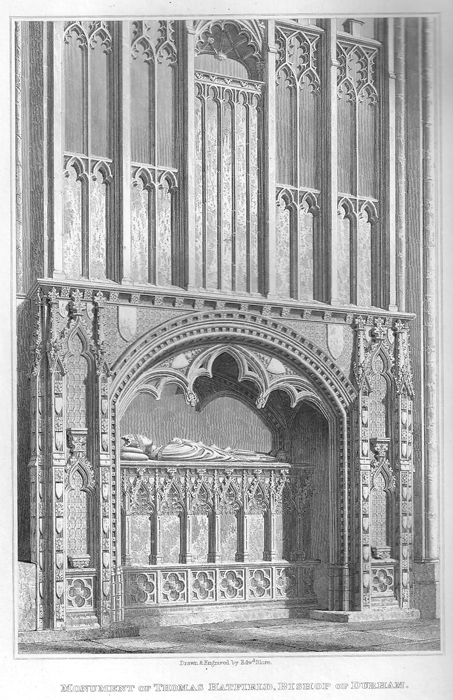 Above: Bishop Thomas Hatfield (1381) (from Blore) |
 Possibly a priest |
 Possibly a lady |
|
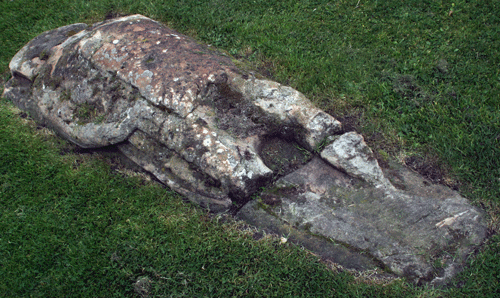 Possibly a knight with straight legs Above: effigies in the church yard |
| A Welcomed Change of Policy to Photography by the Durham Cathedral Authorities, March 2019 |
Before I visit a church to take photographs I normally write to that church to ask permission to do so; I also explain that this is for academic purposes only and not for any commercial purpose or financial gain. I do not write when I plan to visit a cathedral (or a large church) as they are always (in England and Wales) staffed as well as there being a welcome desk, where a request can be made. There may be a reasonable charge or none at all for photography; there may also be restrictions on the use of flash or tripods and even that may apply only to certain parts of the cathedral or certain times of the day. I visited Durham several years ago and was disappointed to see a notice stating No Photography. I asked about this at the welcome desk and was told that photography was only allowed under special circumstances and anyway requires a prior written request. I explained that my request was strictly for academic purposes and that we had travelled several hundred miles to visit Durham Cathedral, so I was reluctantly taken to a cathedral office where I spoke to the person behind the desk there, who told me that the person who can grant permission for photography was away that day. 'Does she not have a deputy who can do so?' I asked. The answer, as expected, was in the negative. I was, however, given a leaflet explaining the rules. The attitude was uncompromising if not frankly absurd. Prior permission would be granted only under special circumstances and only after a written request. The cost was high (possibly I think around £40) and permission was given for a relatively short time only. Then there were other, some rather silly, restrictions: neither tripods nor flash were to be used, the photographs most not feature children or members of cathedral staff, and others that I cannot now remember. This blanket ban has now been lifted as from March 2019. There are still some reasonable restrictions, such as no photography during services, in certain areas and flash is still not allowed. Flash is irritating and can damage delicate and old fabrics; flash is rarely required with modern digital cameras anyway. I am sure that the lifting of this ban will be welcomed by those of us who were disappointed, if not somewhat irritated, by its imposition in the first place. |
| St Margaret of Antioch |
 |
| Crossgate The church dates from Norman times but has undergone various rebuilding and additions in medieval times and extensive Victorian restorations. The earliest monuments date from the 18th century and, although they would scarcely delight the art historian, I have included them because of their simplicity and as a record of social history |
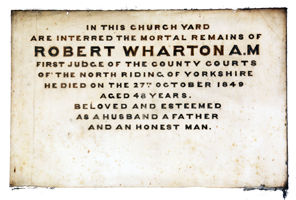 |
 |
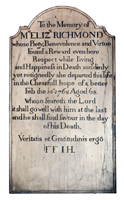 |
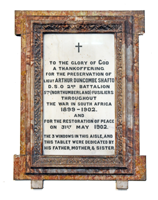 |
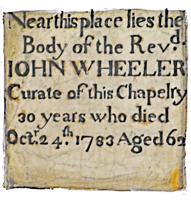 |
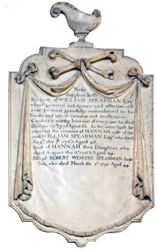 |
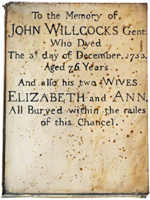 |
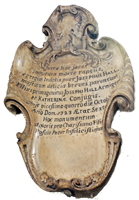 |
| Above from left to right: 1) Robert Wharton AM (1849) First Judge in the County Court of the North Riding of Yorkshire. 2) Elizabeth Richmond (1740) 3) Eliza Richmond (1768) 4) A thanksgiving for preservation of Lt Arthur Duncombe Shafto, 2nd Batt 5th (Northumberland) Fusiliers, throughout the South African War and the restoration of peace. Three windows were dedicated. Not strictly a church monument as such but interesting nevertheless. 5) Rev John Wheeler (1783) Curate of this Chapelry for 30 years 6) William Spearman (1775); his wife, Hannah (1763), their daughter, Hannah (1763), and son, Robert Wemyss (1793). Note that the drapery is held up by crossed bones. 7) John Willcocks (1753), 'And alſs his two WIVES ELIZABETH and ANN 'All Buryed within the railes of this Chancel' 8) Joseph Hall (1723) Latin text | |||||||
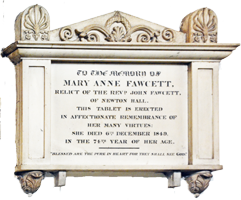 |
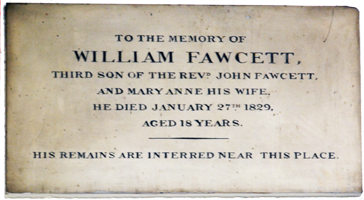 |
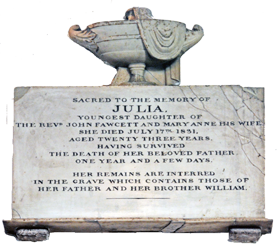 |
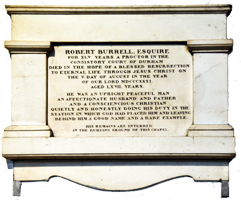 |
| Left: Margaret Wood (1783) Aged 2; her father Clement Wood (1789). There then follows a series of four monuments to the Fawcett family: Rev John Fawcett AM (1830) Sig: Davies & son sculp. Newcastle. Mary Anne Fawcett (1849), 'relict of the Rev John'. Their third son, William (1829). And their youngest daughter, Julia Fawcett (1881). William was 18 and his sister 21. The wall behind Julia's monument appears to have held a gabled backing, now removed. The father and two children were buried in the same grave. Top right: Robert Burrel (1831) 45 years proctor in the Consistory Court of Durham. | |||
| Other Monuments |
| George
Duncombe Shafto (1900) 'This window is dedicated...'
Brass. Rev George Sydney Ellam MA (1905) Assistant curate of this parish 1894-1905; Vicar of Satley 17th April to 13th May 1905; 'on which day he died by an accident at Neville's Cross'. The altar rails in this church and St John's, Neville's Cross were erected by his parishioners and friends. Brass with incised letters pained black but initials of each word red. Rev Percival Spearman Wilkinson (1875) and his wife, Mary (Anstruther) (1842). The East Window was dedicated by their children 1881. Brass with raised letters. |
 |
St Mary the Less | |
| South Bailey So called to distinguish it from St-Mary-le-Bow; both were built as garrison chapels for those guarding the city walls. The church has also been known as Little St Mary, St Mary Parva and The Little Church in the Bailey. It ceased to be a parish church in 1917 when it was taken over by St John's College of the University of Durham. |
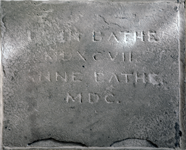 |
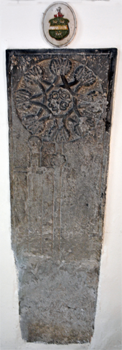 |
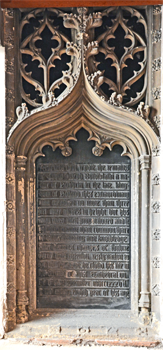 |
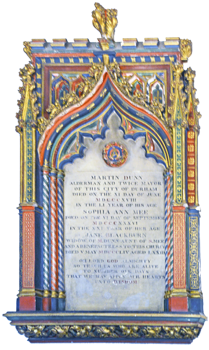 |
| Above:
[JOHN] BATHE (1697)
[A] NNE BATHE (1600)
see below Near right: Cross slab now attached to wall Mid right: Count Józef Borwłaski A Polish entertainer only 3' 3" tall. He toured Europe, retired to Durham, died at 97 and was buried in the Cathedral Far right: Martin Dunn (1818), Alderman and twice mayor; His wife, Jane Blackburn (1854); And niece of the last Sophia Ann Mee (1836) |
| Other Monuments |
The following inscribed stones have been set at some point into the external wall of the church: '... ye Body of ___m Greggs Late Organ[ist] of ye Cathedral Church at Durham Who Died ...1710...' 'IOAN LEVER WIFE OF CVT [Cuthbert?] NICH[O]LLS. DIED ZZ OF MAIE 1590 RS' 'M_DOROTHY CARNABY DYED Ye 19 OF DECEMBER 1684. FRANCES CARNABY DYED APRILL Ye 28 1692 The following are inside the church: John Harley Wadsworth MA (1919) 'Tutor and Censor of St John's College 1909-19' White tablet in raised frame John Dunn and Elizabeth. Also their elder daughter, Sophia (1908) Brass with geometric surround Isabella Paine (Fox) Hayne (1859) White tablet on black base William Granville Maddison (1953) Brass Mary Butler (Butler) (1710) and her brother, William (1708) Wood Rev C S Wallis MA (1924) Principal of St John's College. In his memory the above window was restored. Brass on wooden base Charles Steel Wallis. Vice-Principal (1912-1919), Principal (1919-45), Rector of St-Mary-le-Bow (1930-1945), Hon. Canon of Durham Cathedral (1937-1959) Gray floor slab VAULT DAME ELIZABETH BOW[ES] (1735) AND HER DAUGHTER ELIZABETH BOW[ES] (1759) [THE] BOWES MDCCI[XX] Henry Wilkinson (1798) White tablet Anna Maria Watkins (1838) Oval white tablet, long axis vertical, in black scrolly frame. A wooden tablet on the wall near the John Bathe floor slab, added because the floor slab was becoming illegible. Curiously his wife is not named. 'IVTVS NON MORIETVR IN ӔTERNV, IOHN-BATHE-A ZELOVS-PROTESTANT AND-AVDITOVR TO-THE-L: BVSH: OF DVRHM-WAS-BVRIED-HEAR THE . 25. OF-IVLY ANO DM 1597 BEATI QVI IN DNO MORIVNTVR Thomas Maddison (1908) Brass with stylized floral border Victor Alexander Bradshaw (1874) Sub-Lt RN HMS Encounter. Died at Yan Coomassir on service in the Naval Brigade aged 25 Bertram Lionel Maddison (1916) Lt Col 1st Batt The Yorkshire Regiment. KIA Battle of the Somme whilst commanding 8th Batt the Yorkshire and Lancashire Regt. Aged 34. Brass with stylized floral border Ralph Aylmer Wilson M.C. (1918) 2nd Lt Durham Light Infantry. KIA Estaires, France, 1918. Aged 26 |
 |
St Oswald |
 |
| Church Street Although the earliest visible parts of the church are Norman, there is evidence that it dates back to pre-conquest times. As ever rebuilding and restoration has occurred over the years |
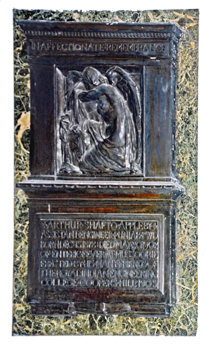 |
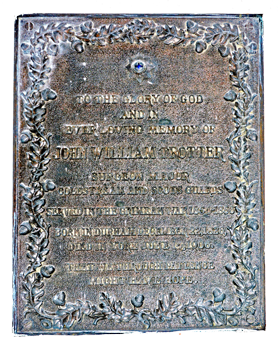 |
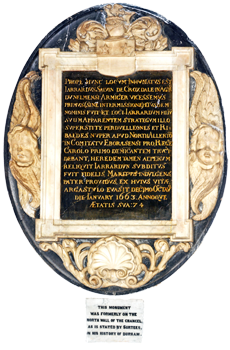 |
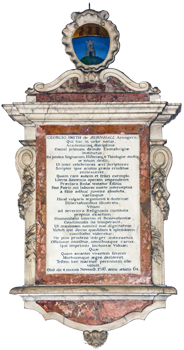 |
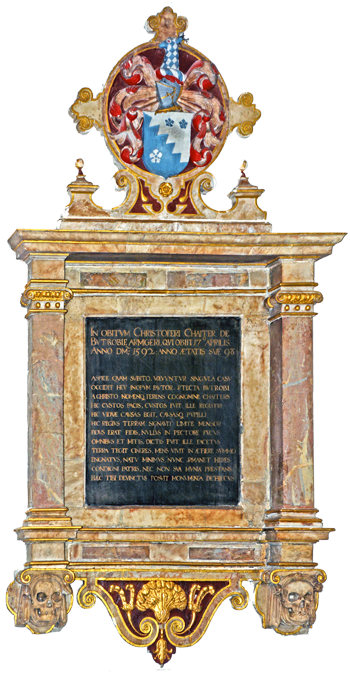 |
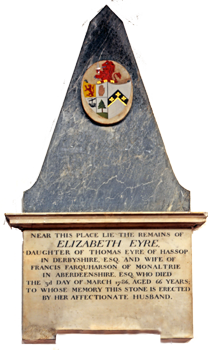 |
| Arthur Shafto Appleby (1919) Engineer |
John William Trotter (1906) Surgeon Major Coldstream Scots Guards |
Jarrad Salvin (1663) † | George Smith (1756) Latin text |
Christopher Chayter (1592) Latin text |
Elizabeth Farquharson (Eyre) (1768) |
| † The small tablet below the monument tells us, rather curiously, that it was formerly on the north wall of the chancel, as recorded in Robert Smith Surtees's The History and Antiquities of the County Palatinate of Durham. (1816) | |||||
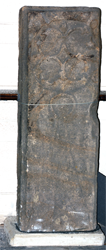 |
Other Monuments |
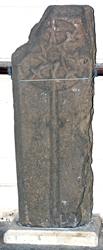 |
| George
Wilkinson (1866) Also added later his wife,
Anne Maria (1870) White tablet with attached frame. Edward Peele JP (1883) The window was erected in his memory. White tablet, long side horizontal. John Tiplady (1865) Solicitor. Town Clerk of the City Eleanor Charlton (Alder) (1805) White tablet on black base. William Green MD (1858) 44 years honorary surgeon to Durham Hospital. White tablet in gothick stone frame by R Beall Sc. Newcastle Maj-Gen Edward Walter Clervaux Chayton KCMG KCVO CB (1939) and his wife, Louisa Jane (1948) Blue oval enameled table with long axis vertical There are a number of stones with foliated cross and other designs, many broken. Left is one probably to an bishop; note the crosier. Below is on in the church yard, very weathered |

